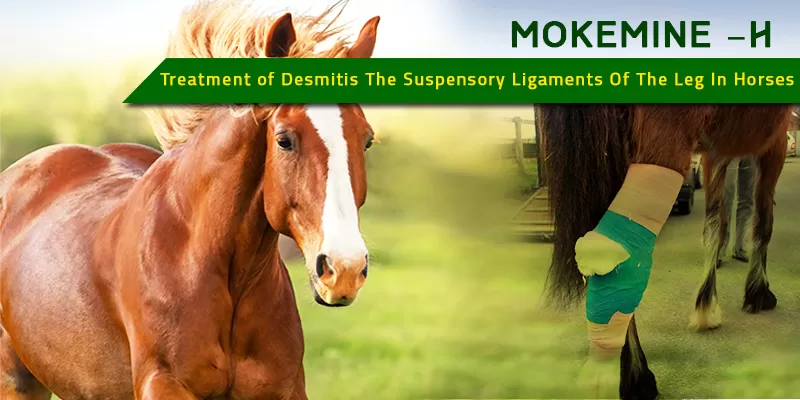A horse’s fluid body movement is completely dependent on the health of his joints. It follows that the health of the joints is dependent on a harmonious flow energy (life-promoting energy) surrounding and through these joints.
Unfortunately, the free flow of energy through the horse’s joints can be easily obstructed by something as simple as cold weather constricting and slowing the flow of energy or as chronic and painful as arthritis…
What is Desmitis of the Suspensory Ligaments of the Leg?
The long suspensory ligaments that are located in the lower legs can become inflamed and swollen. This swelling of the ligaments is referred to medically as desmitis and can cause varying degrees of lameness in the affected horse.
Desmitis, and the underlying damage to the ligament, often take several weeks or even months of restricted exercise to heal, even after more advanced treatments. For equines, this tends to occur most often in the joints of the legs.
Symptoms of Desmitis of the Suspensory Ligaments of the Leg in Horses symptoms and signs you would see with any horse suffering from lameness.
- Behavior changes
- Generalized limping
- Inability to put weight on the limb
- Heat at site of damage or swelling
- Poor performance
- Reluctance to stand
- Swelling
When the injured ligament is affecting the front legs, the horse will often lift its head higher when stepping on the distressed limb, and drop it when putting the weight on the sound limb.
However, when a hind leg or foot is involved the disorder will be most apparent when viewing the horse from behind. When the horse walks, it will lift its hip on the lame side to avoid putting as much weight on it and will allow the other side to dip a little bit to compensate.
Causes of Desmitis of the Suspensory Ligaments of the Leg in Horses
Several factors can cause a specific horse to be more likely to develop desmitis of the suspensory ligament. These can include:
- Jumping and racing athletes
- Horses with crooked limbs
- Shoeing problems
Diagnosis of Desmitis of the Suspensory Ligaments of the Leg in Horses
When dealing with lameness or pain in the limbs of a horse, the diagnosis has two primary goals.
The first goal is to determine from which part of the leg the pain or weakness is originating.
The second goal is to identify what the underlying cause is so that an appropriate treatment plan can be selected.
A flexion test and lameness exam will generally be conducted .Local nerve blocks, a complete blood count and biochemical and a lactic acid test are conducted during the diagnosis.
An ultrasound, MRI, and scintigraphy can be used to check for the swelling or any ligament tear.
Treatment of Desmitis of the Suspensory Ligaments of the Leg in Horses
The first step in treating desmitis of the suspensory ligament is to reduce the swelling and the heat. NSAID pain management medication is frequently employed to reduce the inflammation and swelling both of the ligaments and of the tissues surrounding it, and cold hosing or icing will help lessen the heat of the affected leg.
But these NSAID drugs can often become toxic if by mistake given at higher doses and sometimes prove out to be fatal.
The safest possible and easily available way is the usage of some herbal product which doesn’t carry any side effects along with it and one such is the usage of Turmeric.Turmeric, a spice very widely and commonly used in Indian households is known to carry variety of benefits .But the direct usage of turmeric cannot prove out to be helpful so it needs to be ingested with some other bi component for its better absorption.
Mokemine –H Natural Cure for Desmitis in Horses
Bagdara farms Mokemine –H is a product specially designed only for horses keeping in view the regular health problems they encounter in their daily life. The composition of Mokemine –H contains curcumin which is taken in the exact ratio as is needed to cure the desmitis or other health issues of horses.
Looking in to the some of the ways and benefits of Mokemine –H will let one have better understanding of the product:-
- Turmeric is probably best known for its use as an anti-inflammatory. It works by significantly reducing the inflammatory pathways in the body of the horse
- Horses are susceptible to oxidative stress just like us humans. If your horse is older, if he suffers from any type of chronic condition, or if he’s a performance horse, he very well may benefit from an antioxidant such as turmeric.
- Turmeric lessens the effect of pro-inflammatory cytokines and enzymes like Cox-2 and 5-Lox.
- Offering your horse a brief dose of Mokemine -H before exercise would be both kind and beneficial to enhance his comfort level.
- Turmeric works as a COX-2 inhibitor (as opposed to COX-1) and does not damage the lining of the stomach while treating the desmitis along side.
Dosage for Horses
the exact dosage for Turmeric has not been determined in horses, but as very general guide. In a bowl, mix 1 dessert spoon (to start with) of Mokemine –H powder with approximately 6-8 grinds of freshly ground cracked pepper and 1-2 teaspoons of cold pressed oil (coconut, olive or linseed). Add some water and blend into a paste that can be mixed through the bulk of your horses feed.
Buy Mokemine –H Now and keep Desmitis in Horses away !

